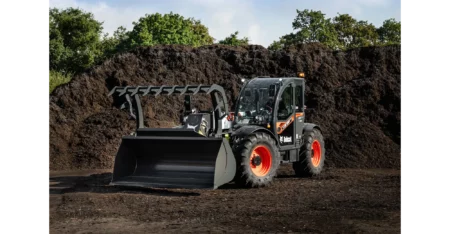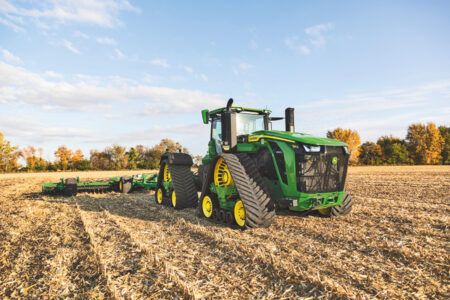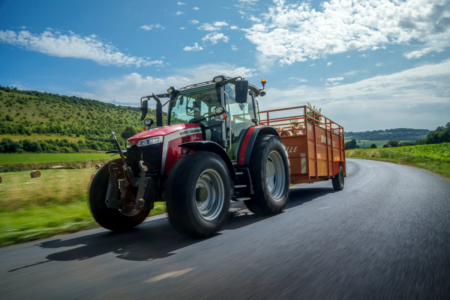MAN Engines has launched a new six-cylinder product aimed at the agricultural industry.
The 9-liter, off-road D1556 engine with a 145mm stroke and 115mm bore has debuted at Agritechnica 2017, which is being held in Hanover, Germany, this week (November 12-18).
Developed from the ground up, the power unit offers between 274hp and 434hp, narrowing the gap between the company’s D0836 and D2676 series.
Reiner Rößner, head of sales at MAN Engines, said, “There are many ways in which the new MAN engine represents a forward-thinking approach. First, its high power density, despite a compact and lightweight design, and the optimal torque and performance profile alongside extremely low fuel consumption.
“Secondly, the D1556 particularly excels due to its high potential for integration in agricultural machinery as well as its countless individual solutions for machinery manufacturers. This is because, with the D1556, MAN Engines is offering OEM manufacturers not just power and torque, but also significant added value to leave the competition behind.
“We want to offer our customers an engine that enables them to market their machine as a premium product.”
With the D1556, the MAN engineers have developed a new diesel engine that is characterized by its high degree of reliability. The reason for that is MAN Engines’s decades of field experience with various assembly situations and load profiles in the off-road sector as well as the transfer of knowledge about other MAN engines to the latest generation.
Established materials and field-tested technology from MAN’s commercial vehicle engine production line equally ensure that both quality requirements are met and that development and production are kept in-house at MAN’s International Engine Competence Centre in Nuremberg. Furthermore, design features such as exhaust system insulation measures offer advantages when used under hot and dusty operating conditions.
The less complex engine without exhaust gas recirculation (SCR only) assists reliability, as does a control system for the exhaust gas aftertreatment system, which is fully integrated into the EDC control unit. Downgraded versions are more sulphur-tolerant and can therefore be deployed all over the world, including in countries with a diesel sulphur content of up to 2000ppm. This facilitates secondary marketing efforts in non-European countries that tend to have higher diesel fuel sulphur contents.
Service options such as extended warranties offer greater convenience in customer service. A proven and close-knit global MAN service network and international on-site assistance provided by MAN’s own engine specialists are available in cases where service is required.
Depending on performance class, thanks to a high ignition pressure and 2500bar injection pressure, the MAN D1556 manages to generate between 205kW and 324kW of power (279hp and 440hp) from an engine size of just nine liters, and thereby generates a maximum torque of 1970Nm between 1150rpm and 1300rpm (324 kW).
Not only that, but with a dry weight of just 860kg (without exhaust gas aftertreatment), the MAN D1556 is the most lightweight engine in its class and has one of the lowest installation volumes when compared to the competition (1414 × 807 × 1103mm).
The MAN D1556 simultaneously achieves the most economical consumption values in the entire engine-map range thanks to its modern design. The new MAN engine thus offers the perfect building block for machinery manufacturers to bring powerful and fuel-efficient machinery to international markets, e.g. self-propelled harvesting machinery (combine harvesters) and tractors, chaff-cutters, shredders, forest machinery and recycling machinery.
The MAN D1556 is impressive even at low engine speeds thanks to a high torque value, with “turbo lag” being eliminated at low engine speeds. A positive side effect of this is that low noise emissions are also retained. Its high power and torque capacity consistently ensure the delivery of dynamic power, even at lower engine speeds, a particularly critical feature for economical operation.
These ideal performance conditions are achieved thanks to a Common-Rail-System with a maximum injection pressure of 2500bar and a turbo charger with variable turbine geometry (VTG). This technology allows the most efficient engine operating range to be customized to perfectly match an extremely wide range of applications.
High compression also ensures more efficient fuel consumption. In the synergy between the integrated interaction of engine components (EDC Engine Device Control) and the Common-Rail-System, thanks to the optimal balance between charge pressure and the quantity, pressure, timing and duration of injection, the conflicting objectives of lower fuel consumption and reduced emissions of pollutants are combined for the best results possible.
Other advantages offered by the VTG turbo charger are its compact dimensions compared to two-stage turbo chargers and its increased brake output without the use of additional components such as a brake flap or valve brake.




